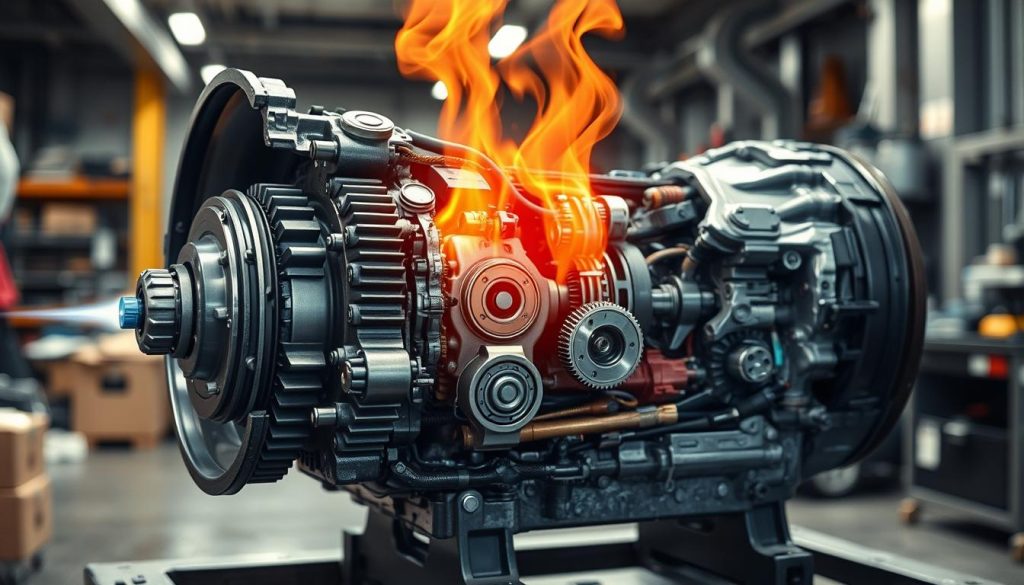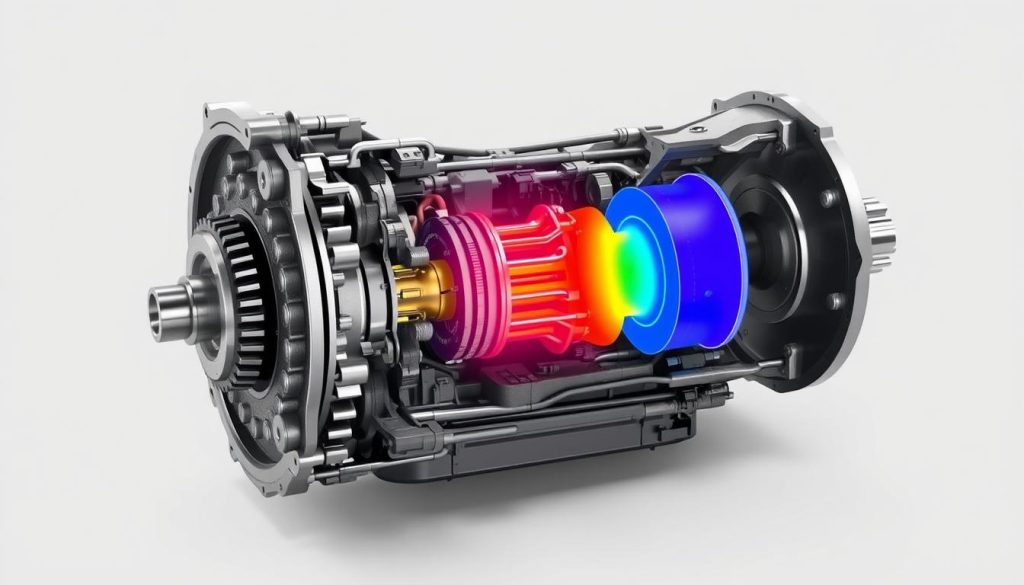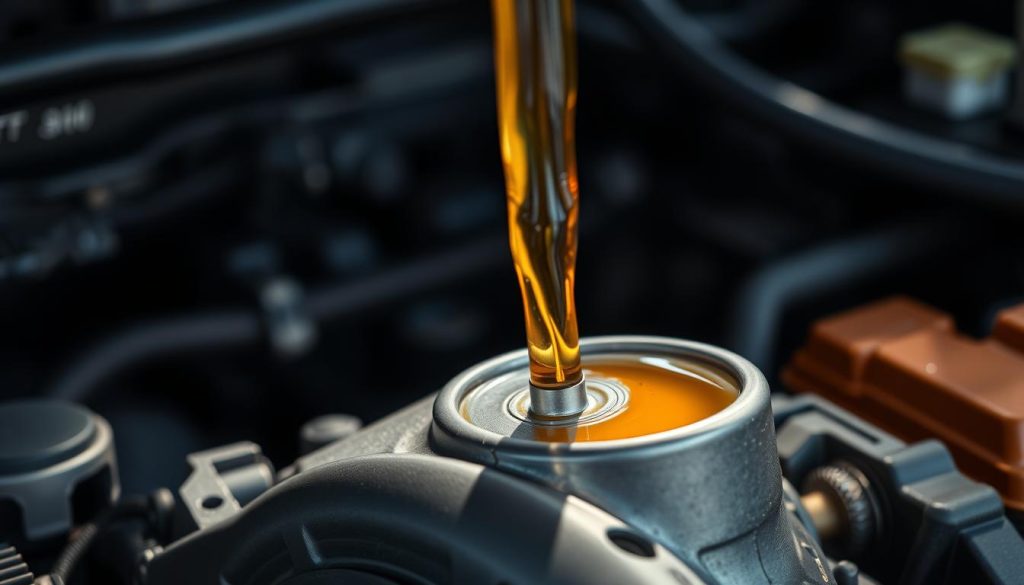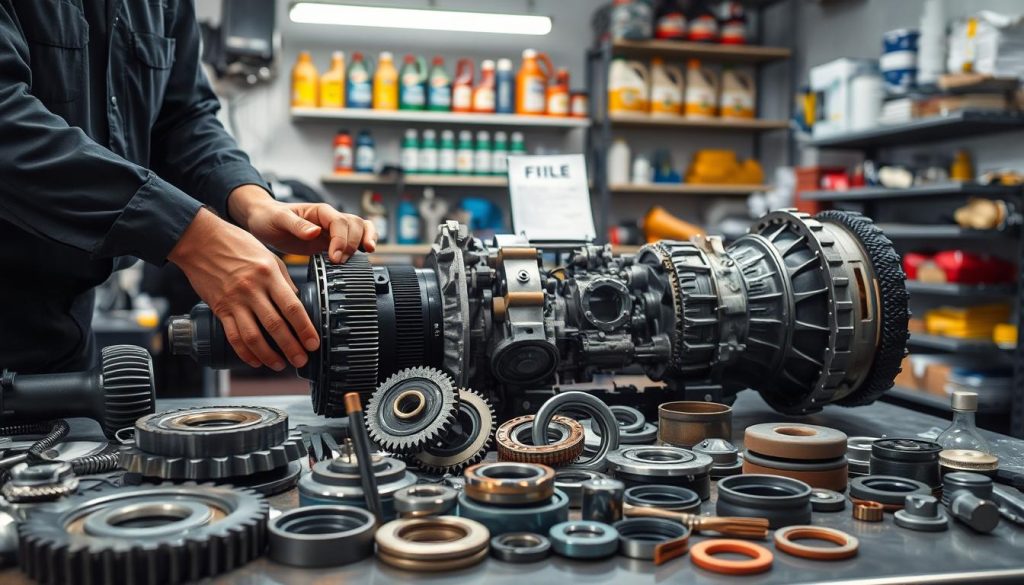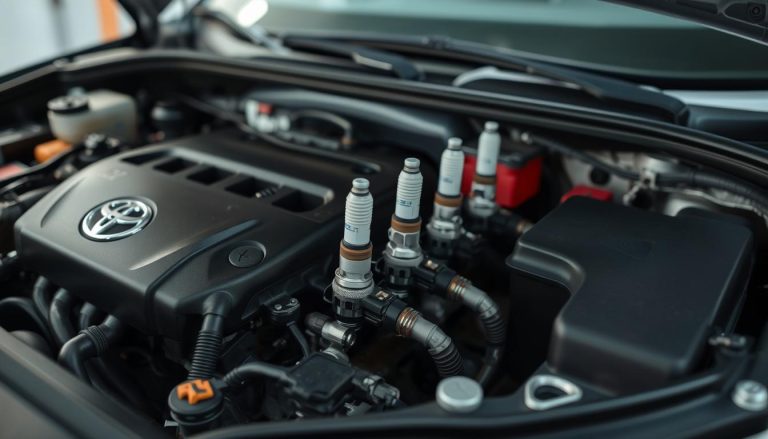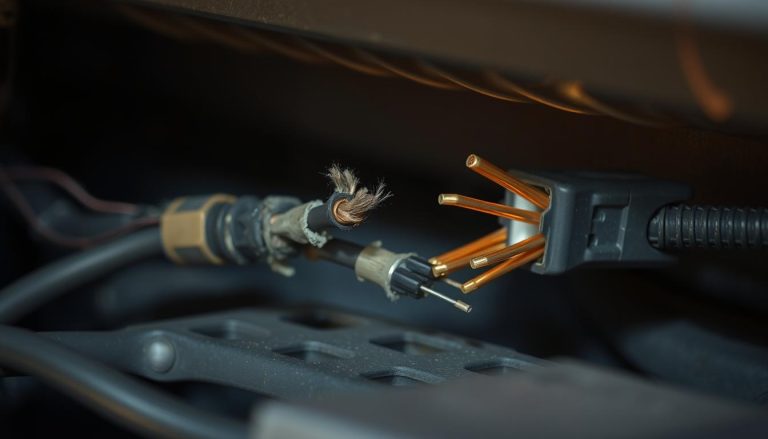Toyota Transmission Overheating: Causes & Fixes
Knowing how your Toyota’s transmission works is key to fixing overheating problems. The transmission is vital as it sends power from the engine to the wheels. It makes sure the car moves smoothly and efficiently.
But, if it overheats, you could face big problems with your car. It’s important to understand why this happens. Knowing the causes helps keep your car running well for a long time. It also helps avoid expensive repairs and keeps you safe on the road.
Understanding Transmission Overheating
Many car owners face the problem of transmission overheating. This issue often stems from different causes. One key factor is the temperature of the transmission fluid. It’s vital for the fluid to stay cool to work well.
When the fluid gets too hot, it can’t lubricate and cool the system properly. This can put a lot of stress on the transmission parts. It might even cause them to fail.
Several things can make the transmission system too hot. These include low fluid levels, leaks, or dirty fluid. It’s important to know how to stop the transmission from overheating.
Regular car maintenance is key. This includes checking and changing the transmission fluid. Also, make sure the cooling system works right. And don’t overload your car.
Keeping an eye on the transmission fluid temperature is also important. A transmission temperature gauge can help you watch the temperature closely. This way, you can act fast if the temperature gets too high.
Knowing how to prevent transmission overheating can make your car last longer. It also helps it run better. By staying on top of maintenance, you can avoid expensive repairs and keep your car in top shape.
Common Causes of Toyota Transmission Overheating
Toyota transmission overheating can happen for many reasons. We’ll look at some common causes in Toyota vehicles.
Transmission Fluid Problems
Transmission fluid issues are a big cause of overheating. If the fluid level is low or its quality is bad, it doesn’t lubricate well. This causes friction and heat, making the transmission overheat. Regular checks and timely fluid replacements can stop these problems.
Driving in Hot Weather
Hot weather also makes Toyota transmissions overheat. In very hot conditions, the system gets hotter, more easily. It’s important to keep the cooling system working right and the fluid levels up during summer.
Towing Heavy Loads
Towing heavy loads stresses the transmission, causing it to overheat. This is more true in hilly or mountainous areas. Using the right transmission fluid and checking fluid levels helps manage this stress.
Driving in Heavy Traffic
Driving in heavy traffic, with lots of stopping and starting, also overheats the transmission. The constant shifting and braking put a lot of strain on it. Keeping an eye on the fluid and maintaining the system helps prevent overheating.
Signs of a Transmission Overheating
Spotting signs of transmission overheating early can prevent expensive fixes and keep your car running well. Here are key signs to watch for:
Transmission Slipping
One clear sign is when your car’s gears slip. This makes the car speed up and slow down erratically. If you notice this, fix it fast.
Low Transmission Fluid Level
A low fluid level hurts your car’s ability to cool and lubricate the transmission. Always check and keep the fluid level right to avoid overheating.
Burnt Transmission Fluid
A burnt smell from the transmission fluid is another warning sign. This smell happens when the fluid gets too hot. If you smell it, your transmission might be overheating.
Solenoid Malfunction
Solenoids help control fluid flow in the transmission. Heat can make them malfunction, causing shifting problems. Fixing solenoid issues quickly helps avoid more damage.
Impact of Overheating on Transmission Health
Overheating can harm your transmission’s health in many ways. It can make parts wear out faster, leading to problems with how the transmission works.
Premature Wear and Tear
When a transmission overheats, it puts a lot of stress on its parts. This stress can cause the clutch plates, bands, and gears to wear out early. The heat also makes the transmission fluid break down faster, which means it can’t cool and lubricate as well.
This shortens the life of the transmission. You might need to fix or replace it more often, which can be expensive.
Potential Transmission Failure
If you don’t fix the overheating problem, it could lead to a complete failure of the transmission. The heat weakens the metal and seals, making it more likely to break down or leak. In the worst cases, the transmission might stop working altogether and need to be replaced.
This can be very costly. It shows how important it is to fix overheating problems early to avoid big damage.
Knowing why your transmission overheats helps you take action and prevent problems. Here’s a look at what overheating can do:
| Impact | Description | Potential Consequences |
|---|---|---|
| Premature Wear and Tear | Accelerated degradation of transmission components. | Increased maintenance costs and reduced lifespan. |
| Complete Transmission Failure | Severe damage to the transmission system. | High repair costs or need for full transmission replacement. |
The Role of Transmission Fluid
Transmission fluid is key to your car’s performance and life span. It cools and lubricates the transmission, making gear shifts smooth. Keeping the fluid quality and levels right is vital for avoiding overheating and ensuring your car works well under different conditions.
Good transmission fluid cuts down on friction in the transmission parts. This reduces wear and tear, making your transmission last longer. It also cools the transmission during heavy tasks like towing or driving in heavy traffic. This cooling is critical to avoid damage and expensive repairs.
Checking the transmission fluid level and quality regularly is important. Clean, fresh fluid works better and prevents sludge buildup. This keeps your transmission running smoothly.
Here’s a quick guide to understanding the importance of transmission fluid versus neglecting its maintenance:
| Aspect | Maintained Transmission Fluid | Neglected Transmission Fluid |
|---|---|---|
| Gear Transition | Smooth and Efficient | Rough and Sluggish |
| Heat Dissipation | Effective | Ineffective, Leads to Overheating |
| Wear and Tear | Minimized | Accelerated |
| Overall Lifespan | Extended | Shortened |
Following these transmission maintenance tips can greatly improve your car’s performance. It also helps prevent overheating and other issues.
How to Check Transmission Fluid Level
Keeping your Toyota’s transmission running smoothly starts with checking fluid levels regularly. The right amount of fluid is key for lubrication and cooling. It helps avoid overheating problems.
First, park your car on level ground and let the engine warm up. Look in your owner’s manual for how to do this. You’ll find the transmission dipstick. Pull it out and clean it with a lint-free cloth.
Then, put the dipstick back in and pull it out again. Check the fluid level. It should be between the “Full” and “Add” marks. If it’s low, add the right type of transmission fluid as Toyota suggests.
Regularly checking your transmission fluid helps catch problems early. Ignoring this can lead to big issues. But by checking fluid levels regularly, you keep your car running well and last longer.
If the transmission fluid looks burnt or smells odd, get professional help. Regular checks are important to spot these signs early. This keeps your transmission healthy.
Importance of Regular Transmission Maintenance
Regular maintenance is key to avoiding big problems with your Toyota’s transmission. By checking and changing the transmission fluid regularly, you can make your car’s transmission last longer. This also saves you from expensive repairs.
Transmission Maintenance Tips
There are several important steps to keep your transmission running smoothly.
Checking Fluid Levels Regularly
Checking your transmission fluid levels is a simple yet effective step. Keeping the fluid at the right level helps your transmission work smoothly. It also prevents it from overheating.
Changing Transmission Fluid
It’s important to change your transmission fluid on time. The fluid can get dirty and lose its effectiveness over time. Changing it regularly keeps your transmission well-lubricated. This reduces friction and prevents overheating.
How to Prevent Transmission Overheating
Keeping your Toyota’s transmission cool is key to its long-term health. A few simple steps can help a lot. These include keeping the cooling system in check, adding a transmission cooler, and driving smart.
Maintain the Cooling System
First, make sure your car’s cooling system is up to par. Check the radiator and coolant levels often. This keeps the transmission from getting too hot.
Install a Transmission Cooler
Adding a transmission cooler is a smart move. It helps keep the transmission at a safe temperature. This is super useful when you’re towing or driving in the heat.
Adopt Proper Driving Habits
Driving right can also prevent overheating. Try to avoid long drives in heavy traffic. Also, don’t overload when towing. And, gentle on the gas and brakes to ease the strain on your transmission.
Transmission Cooling System and Its Function
The transmission cooling system is key to your vehicle’s health. It manages the heat that builds up when the transmission works. This keeps your transmission at the right temperature, avoiding damage from too much heat.
When the transmission gets too hot, it can cause serious problems. This includes fluid breakdown and damage to parts. So, it’s important to keep the cooling system in good shape. It includes parts like the radiator, cooler, and coolant lines, all working together to keep the temperature stable.
Regular checks on the cooling system are a must. You should look at the fluid levels, check for leaks, and make sure the coolant paths are clear. These steps help your transmission last longer and improve your car’s performance.
Knowing how the cooling system works helps keep your car reliable and long-lasting. A well-maintained system means a worry-free drive and better performance.
Diagnosing Transmission Issues Early
Identifying Toyota transmission problems early can save you money on repairs. Spotting signs of transmission overheating early can prevent major damage. It also helps keep your vehicle’s transmission running longer.
Pay Attention to Warning Signs
If your car makes unusual noises, shifts gears slowly, or smells like burning, act fast. Other signs include the transmission slipping and feeling harsh when shifting gears.
- Unusual noises when shifting gears
- Delayed gear engagement
- Burning smell emanating from the transmission
- Transmission fluid leaks
- Check engine light related to transmission errors
Knowing these signs of transmission overheating and fixing them early can prevent big problems. Regular checks and maintenance are key to keeping your car running well.
| Warning Signs | Possible Causes |
|---|---|
| Unusual noises | Worn or damaged transmission components |
| Delayed gear shifts | Low or contaminated transmission fluid |
| Burning smell | Overheating transmission fluid |
| Transmission slipping | Failing transmission clutch |
When to Seek Professional Help
Knowing when to get help for transmission overheating can save you money. If you see signs like a burning smell or slipping, get a pro’s help. Waiting too long can cause big damage.
Signs like a burning smell or unusual noises mean you need an expert. Ignoring these can lead to expensive repairs. These can take a lot of time and money.
Experts can find out why your transmission is overheating. It might be fluid issues, mechanical problems, or something else. Getting help early keeps your car running well and your transmission lasting longer.
In short, don’t wait to get help if your transmission is acting up. A pro can stop big problems and keep your Toyota running right.
Toyota Transmission Overheating: Causes & Fixes
Fixing Toyota transmission overheating starts with finding the main causes. Often, it’s because of too little or old cooling transmission fluid. This fluid helps lower friction and heat in the system.
A broken transmission cooling system is another big problem. This system is key for getting rid of heat while driving. Keeping it working right can stop many overheating issues.
It’s important to take care of your car ahead of time. Check and change cooling transmission fluid often. Also, make sure the transmission cooling system is in good shape. Doing these things helps keep your Toyota running smoothly and lasts longer.
Conclusion
Keeping your Toyota’s transmission in top shape is key to its performance and reliability. Knowing why transmissions overheat and how to stop it is important. Regular checks and fluid changes, along with smart driving, can help a lot.
Spotting early signs of trouble, like slipping or burnt fluid, helps avoid bigger problems. Adding a transmission cooler and keeping the cooling system in check are also smart moves. These steps protect your Toyota’s transmission.
Being aware of transmission issues and acting fast is vital. Getting professional help when needed and following maintenance advice are musts. These steps keep your car running smoothly, giving you peace of mind on the road.
FAQ
What are common causes of Toyota transmission overheating?
Low or degraded transmission fluid is a big cause. Driving in hot weather and towing heavy loads also strain the transmission. Frequent stop-and-go traffic adds to the friction.
What are the signs of a transmission overheating in Toyota vehicles?
Signs include slipping gears and low fluid levels. Burnt fluid and solenoid malfunctions are also signs. Catching these early can avoid bigger problems.
How does overheating impact transmission health?
Overheating wears down transmission parts quickly. If not fixed, it can lead to a complete failure. This can be very expensive to repair or replace.
What role does transmission fluid play in preventing overheating?
Fluid keeps the transmission cool, lubricated, and shifting smoothly. Keeping it at the right level prevents overheating and keeps the transmission running well.
How do you check the transmission fluid level in a Toyota?
Use the dipstick method from the owner’s manual. It’s important to check the level regularly to keep the transmission running smoothly.
Why is regular transmission maintenance important?
Regular checks and changes of the fluid prevent overheating. This helps the transmission last longer and keeps the car running well.
How can I prevent my Toyota transmission from overheating?
Keep the radiator system in good shape. Installing a transmission cooler helps too. Avoid towing too much and try to drive smoothly.
What is the function of the transmission cooling system?
The cooling system manages the heat from the transmission. It keeps the temperature stable to prevent overheating and ensures the car runs efficiently.
How important is early diagnosis of transmission issues?
Catching problems early is key to avoiding major damage. Listen for unusual noises or smells, and watch for delayed shifts. This can help spot issues before they get worse.
When should I seek professional help for my Toyota transmission?
If you notice persistent problems or overheating, get help from a mechanic or transmission specialist. Quick action can prevent serious damage and keep your car running right.


